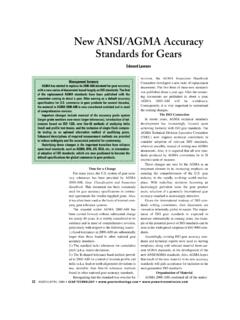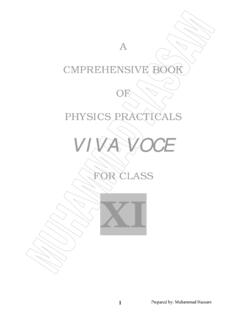Transcription of Design Parameters for Spline Connections
1 Design Parameters for Spline ConnectionsDr. Hermann J. StadtfeldIntroductionSplines are machine elements that connect a shaft with a rotor. Next to transmitting torque, the Spline might also be utilized to center the rotor to the shaft. It is interesting that the Spline s tooth profiles are involutes, although the involute profile does not contribute to the torque transmission, nor is it linked to the centering function. The reason for the involute profile is the fact that most external splines are manufactured by hobbing with a standard straight-sided, symmetric hob tooth profile that is fast and delivers good accuracy results. The internal Spline has to be manufactured with shaping or broaching, using an involute cut-ting tooth profile. The nomenclature and Parameters of a typical Spline connection are presented (Fig. 1). The Spline connection in Figure 1 is neither centering on the flanks nor on its major or minor exception to the involute profiles is the parallel straight profile Spline that requires a planning operation for the external member and a single tooth shaping or broaching of the internal member.
2 Splines can be organized into 2 main categories and 4 sub-categories that are defined by national and international standards; an overview is given (Fig. 2).Studying the literature teaches that many large OEM s pick the Design proposals, the tolerances and function features for one particular Spline Design from several standards. Here it will be proposed to use metric units for all calculations, applying the addendum/dedendum recommendation by DIN and following the ANSI guideline for side fit and major diameter fit. In order to eliminate the confusion that the Design by picking dimen-sions and tolerances from different standards might cause, the following sections present a firm guideline for each step of the Design , tolerancing and cutting tool Different Spline Functions and the Required FitsIf a splined shaft that is, for example, the output of a trans-mission drive with a rotor that is mounted on its own bearings, then the function of the Spline is not the centering of the rotor but merely torque transmission.
3 In this case, a centering func-tion would just cause the transfer of misalignment and runout between shaft and rotor, which leads to vibration and bearing wear. The described connection should have backlash between the flanks and clearance between the top of the internal and external teeth and their adjacent roots, and use a profile fit with backlash (Fig. 3).If a splined shaft is connected with the internal Spline , for example at the output of a transmission and if the shaft is long in relation to its diameter, then a flank-centered fit as shown (Fig. 4) is preferred. In order for correct flank center-ing, the backlash between the internal Spline teeth and the shaft Spline teeth must be zero. To achieve such a transitional fit, the tolerances according to ISO 7H (shaft Spline ) and 7n (internal Spline ) are a case where a rotor like a sprocket is radially centered by the Spline connection , then major diameter transition fit (or interference fit) according to ISO (outside shaft diameter toler-ance H7 and major internal diameter tolerance n7 (or H7/p7 for a press fit) can be used (Fig.))
4 5). The profiles can be made with backlash or as transition or interference fit (see tolerance recommendations in connection with Figs. 3 and 4). The deci-sion regarding the flank fit depends on the operation schedule Figure 1 Design Parameters for 2019 | GEAR TECHNOLOGYF igure 2 Overview of different Spline categories [1 through 7].Figure 3 Not centering 4 Flank centered TECHNOLOGY | September/October 2019[ ]technical(one-directional or two-directional torque transmission).The parallel straight-sided Spline has straight-sided teeth on the Spline shaft and straight-sided slots on the internal spine. To calculate addendum and dedendum, the formulas either from the ANSI or the ISO standard can be used. In a metric calculation like that shown before, the ISO tolerance recommendations are appropriate for diameters and tooth thickness versus slot width.
5 An example for a straight-sided Spline is shown (Fig. 6).The effective pressure angle can be calculated from the triangle in Figure 6, using the reference diameter as hypot-enuse and the tooth thickness as the opposite side. The straight-sided Spline according to AGMA has checks at the root fillets (Fig. 6). There is no particular preference in the standards regarding diameter fit or flank fit. Also, for the parallel-sided Spline it is common to either use a major diameter fit with clearance on the flanks or a major diam-eter fit with a gentle fit or press fit on the flanks. Flank fit without major diameter fit is uncommon because a radial misalignment due to a press fit is more likely than is the case of splines with non-parallel Spline DimensionsThe example Spline (Fig. 7) transmits the torque of a sprocket to the splined shaft (or vice versa) and centers the sprocket radially.
6 The example sprocket Spline has metric dimensions. Although it is proposed in this article to use metric dimensions for all calcula-tions, later, for the search of a suitable standard hob, the module can be converted into diametral pitch in order to find the closest hob either in the metric or in the imperial tooth depth is calculated using the difference between major and minor diameter divided by two:Depth = (dMajor dMinor)/2 = 2 mmThe tooth proportions addendum and dedendum relate the depth to the still-unknown module:Depth = hK + hF = *m + *mThis relationship allows to calculate a module of:m = = the known module it is now possible to calculate adden-dum and dedendum:Reference addendum: hK = *m = mmReference dedendum: hF = *m = mmBoth dimensions, hK and hF, are reference values that split the tooth depth into the reference addendum and the reference dedendum.
7 This means that neither of the values is related to the pitch circle. The pitch diameter is calculated like for a standard spur gear by multiplying the module with the number of teeth:d0 = m*z = mmIt can be recognized that the pitch diameter is smaller than the minor diameter of the Spline . Because the Spline is not a meshing gear member, there is no working pitch diameter and the meaning of the pitch diameter is primarily important for the choice of the hob cutter and/or the broach. However, it is Figure 5 Major diameter centered connection with gentle flank 6 Parallel straight sided 2019 | GEAR TECHNOLOGY meaningful to calculate a reference diameter that separates the reference addendum and the reference dedendum:dRef = dMinor + 2*hF = mmThe difference between the pitch diameter and the reference diameter can now be used to calculate the profile shift, which is:x*m = (d0 dRef)/2or:x = (d0 dRef)/(2*m) = initially calculated module of mm will not allow utilizing a standard broach for the internal sprocket Spline .
8 If the module is now rounded to a number from the DIN/ISO table of preferred modules, then the rounding to mm is module: mFinal = mmThis module rounding is without any tangible consequence if the Spline shaft, as well as the sprocket Spline , are together in the Design and manufacturing planning stage. If the sprocket Design is done for an aftermarket purpose, and has to fit on an OEM shaft Spline , then the working pressure angle at the reference diameter might show some mismatch. In the present case the rounding was only small and pressure angle mismatch will be within an acceptable the new, rounded module the previ-ously calculated addendum and dedendum values have to be preserved. However, the original fac-tors for the calculation of addendum and deden-dum (hK = *m and hF = *m) have changed by the module rounding.
9 This fact is not relevant, because the mm-value of the sum of addendum and dedendum remain the same, as well as the top-root the module rounding, the pitch diameter and the profile shift factor have to be recalculated:d0 Final = mFinal*z = mmxFinal*mFinal = (d0 Final dRef)/2xFinal = xInternal = (d0 Final dRef)/(2*mFinal) = Spline set always has a V0 profile shift relation which means:xInternal + xExternal = 0andxExternal = xInternal = + the Spline Pressure AngleIf the splines are being designed, then one of the preferred pres-sure angles from the standards should be used. ANSI and DIN offer the choice between 30 , and 45 . In the JIS standard also a pressure angle of 20 is the Spline is designed for an aftermarket product (for example the sprocket shown Fig. 7), then a simple measure-ment preferably on a CMM or with a vernier caliper as shown (Fig.)
10 8) can be conducted to obtain a first pressure angle estimation. If the aftermarket product is the sprocket (not the shaft), then it would be desirable to obtain the measurement explained in Figure 8 on the Spline measurement results are used together with the depth of the Spline tooth to calculate the approximated pressure angle: approx = arctan[2*Depth/(t1 t2)]For the example in Figures 6 and 7 with a topland t2 = mm, a root width t1 = mm, and a depth of mm the Figure 8 Measurement of topland root and 7 Example sprocket with internal TECHNOLOGY | September/October 2019[ ]technicalapproximated pressure angle is: approx = arctan[2* ( )] = The approximated angle is between the preferred angle and 45 from the standards. The difference from 45 is and the difference from is only . The decision therefore is : External = Internal = is a popular pressure angle for splines, which also indicates that the result of measurement and calculation is realistic.










